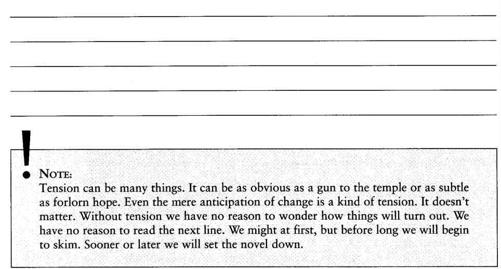Read Writing the Breakout Novel Workbook Online
Authors: Donald Maass
Writing the Breakout Novel Workbook (30 page)
Do you think you are the exception? Of course you do. Do you want to take that risk that you are wrong? That's a tougher call, isn't it? There's just a shred of doubt in your mind.
Could there be just a wee bit more tension in my manuscript?
Count on it. There could be much more. Let's see how some breakout novelists get through material that trips up many others.
How interesting is it to hear two people passing the time of day? Usually, not very. Why is it, then, that so much dialogue in manuscripts is of the how-are-you-would-you-like-a-cup-of-coffee variety? Mere talk does not keep us glued to the page. Disagreement does. Friction in dialogue arrests our attention. It begs the unspoken question: Will these people be able to resolve their differences? We slow down and read the next line to find out.
Mystery writer Harlan Coben knows that empty dialogue cannot satisfy. Even when two characters are allies, he sets them against each other, albeit sometimes in friendly fashion. Toward the beginning of
Gone for Good,
Coben's protagonist, Will Klein, goes to his job as a senior director and runaway counselor at New York's Covenant House. There we are introduced to one of the shelter's street workers, a part-time yoga instructor, Squares, so nicknamed for the geometric tattoo on his forehead.
Will and Squares are fast friends, but you might doubt that as Will thanks Squares for bringing flowers to Will's mother's recent, and lightly attended, funeral:
"Thanks for sending the flowers," I said.
Squares didn't reply.
"And for showing up," I added. He had brought a group of Covenant House friends in the van. They'd pretty much made up the entire nonfamily funeral brigade.
"Sunny was great people," he said.
"Yeah."
A moment of silence. Then Squares said, "But what a shitty turnout."
"Thanks for pointing that out."
"I mean, Jesus, how many people were there?"
"You're quite the comfort, Squares. Thanks, man."
"You want comfort? Know this: People are assholes."
"Let me get a pen and write that down."
Silence. Squares stopped for a red light and sneaked a glance at me. His eyes were red. He unrolled the cigarette pack from his sleeve. "You want to tell me what's wrong?"
"Uh, well, see, the other day? My mother died."
"Fine," he said, "don't tell me."
The light turned green. The van started up again. The image of my brother in that photograph flashed across my eyes. "Squares?"
"I'm listening."
"I think," I said, "that my brother is still alive."
A less experienced novelist would strive to show the warmth and support between these two friends. Coben knows that tension all the time is more important, and so shows us their friction, letting the friendship under the surface show through.
Janet Evanovich is another mystery writer who understands the importance of tension on every page. In fact, it is her mastery of constant conflict that allows her in
One for the Money
, the debut of her popular series heroine Stephanie Plum, to go against the principle I was pushing in the previous chapter and to open her novel with a lump of backstory.
How does she do it? The backstory concerns the childhood of Stephanie Plum and in particular her seduction (twice) by neighborhood bad boy Joe Morelli. In itself this is not particularly interesting—we all have childhood stories to tell—nor can this piece of backstory be wholly carried off by Stephanie's wickedly ironic first-person narration, either. But look closely, and you will see that Evanovich cleverly sets up conflict in these passages.
Take, for example, the first time Joe seduces Stephanie, wKen she is six. As I mentioned earlier, he lures her (willingly) into a garage to teach her a dirty game called "choo-choo." Evanovich does not simply relate the incident; instead, she precedes it with a stern, if vague, warning by Stephanie's mother:
When I was a kid I didn't ordinarily play with Joseph Morelli. He lived two blocks over and was two years older. "Stay away
from those Morelli boys," my mother had warned me. "They're wild. I hear stories about the things they do to girls when they get them alone."
"What kind of things?" I'd eagerly asked.
"You don't want to know," my mother had answered. "Terrible things. Things that aren't nice."
From that moment on, I viewed Joseph Morelli with a combination of terror and prurient curiosity that bordered on awe.
Did you notice the key words in the passage above? Stephanie didn't just ask her mother for more information about Morelli's rumored bad behavior— she "eagerly asked." When the exact nature of the bad behavior is left unspoken, Stephanie regards Morelli with a "prurient curiosity" that is, to say the least, a bit unusual for a six-year-old. Thus, Evanovich quickly uses what might have been an ordinary scene to set up tension: For good reasons Stephanie's mother wants her to keep her away from Joe Morelli, yet Stephanie is dying of curiosity about him. What will happen? Who will win out, Stephanie or her mom—or Joe Morelli?
Those questions now underlie this piece of backstory, and we eagerly read the next few paragraphs to see how things turn out. Evanovich then immediately uses the same technique in setting up the second seduction of Stephanie by Joe, this time behind a display case filled with eclairs at Tasty Pastry, the bakery where sixteen-year-old Stephanie works after school. Again, Stephanie is warned in advance:
My best friend, Mary Lou Molnar, said she heard Morelli had a tongue like a lizard.
"Holy cow," I'd answered, "what's that supposed to mean?"
"Just don't let him get you alone or you'll find out. Once he gets you alone . . . that's it. You're done for."
I hadn't seen much of Morelli since the train episode. I supposed he'd enlarged his repertoire of sexual exploitation. I opened my eyes wide and leaned closer to Mary Lou, hoping for the worst. "You aren't talking about rape, are you?"
"I'm talking about lust! If he wants you, you're doomed. The guy is irresistible."
Will Stephanie escape Joe's clutches? Does she even want to? The tension inherent in the unspoken questions that Evanovich now has planted in the reader's mind makes the next couple of paragraphs impossible not to read. When is Stephanie going to encounter Joe next? What will happen when she does?
In any novel, it is difficult to avoid slack moments when nothing overtly is happening. Such a moment occurs early in Eoin Colfer's
Artemis Fowl,
which I discussed earlier. Twelve-year-old criminal mastermind Artemis is bent on capturing a fairy. With his obedient butler, Butler, he has staked out an ancient oak tree by a river bend where he is certain he eventually will observe, and
snare, a fairy come to renew its magic under a full moon. But this takes time. Four months pass with Artemis and Butler crouched in a sort of high-tech duck blind:
It was always the same. They would crouch in their foil-lined blind in complete silence, Butler repeatedly checking his equipment, while Artemis stared unblinking through the eye of the scope. At times like these, nature seemed deafening in their confined space. Butler longed to whistle, to make conversation, anything to break the unnatural silence. But Artemis's concentration was absolute. He would brook on interference or lapse of focus. This was business.
Notice how Colfer introduces tension into a paragraph in which nothing at all is happening; indeed, which portrays inaction. Silence must be maintained during the fairy watch, yet Butler longs to make noise. If he does his employer will be displeased. Nothing happening? Dig deeper. There is plenty of tension to be mined in a slack narrative moment.
Dialogue, backstory, slack moments—these are just three of many low-tension danger spots that breakout novelists make can riveting. It's so simple, really, and yet so many manuscripts that arrive at my office go right back to their authors in their self-addressed stamped envelopes. Why? The number one reason is insufficient tension. Believe it: Tension on every page works. Low tension does not. Make it your mantra.
____EXERCISE
Adding Tension to Every Page
Step 1: |
 |
Step 2: |
 |
Follow |
 |
Follow-up work 2: |
 |
Follow-up work 3:
Go through all the pages of your novel in random order and raise the tension on each one.
